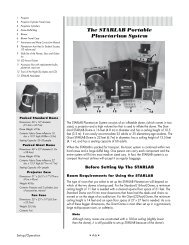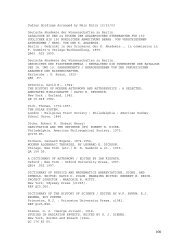K-6 Activities - Dudley Observatory
K-6 Activities - Dudley Observatory
K-6 Activities - Dudley Observatory
You also want an ePaper? Increase the reach of your titles
YUMPU automatically turns print PDFs into web optimized ePapers that Google loves.
K–6 <strong>Activities</strong> • B–24 •<br />
on the disk is set to correspond with the time of observing. Face south and hold<br />
the Star Finder in such a manner that the stars can be read and the south on the<br />
finder points towards the South Pole. Continue holding the finder in position and<br />
use the flashlight to locate the stars which match those in the sky. The Finder is<br />
designed for latitudes 30° N through 50° N but is useful at any northern midlatitude.<br />
5. After dimming the side lights enough for more stars to be seen, ask the students<br />
to use their Star Finders as above to identify a constellation and/or star as you<br />
point it out on the dome.<br />
6. After the above step is accomplished to your satisfaction, turn the side lights<br />
down completely and let students observe the “real sky.” Let students use the arrow<br />
pointer to outline constellations on the dome.<br />
7. Sum up the planetarium experience of the value of a Star Finder.<br />
Follow-up <strong>Activities</strong><br />
1. Each student should take his/her Star Finder home and use it to locate the same<br />
asterisms and constellations in the nighttime sky that he/she observed in the<br />
planetarium.<br />
2. Plan a night observation session with students and use the Star Finder to locate<br />
objects in the real sky. (For a star party, incorporate activities for parents.)<br />
3. Ask several students to make a comparative study of other types of star finders<br />
and to use one or more of them. They should report results to the class.<br />
4. Assign charts of various types to other students, with the request that they locate<br />
five stars in the sky at night and later report on their stargazing experiences.<br />
Evaluation<br />
Point to a constellation or asterism (one or several) and ask students to locate it on<br />
their Star Finders, marking it with a circle. Evaluate each student on his performance<br />
in the post activities. List several stars and constellations by name and ask students to<br />
use their Star Finders to determine the month each star and constellation would be visible<br />
at 10:00 p.m. and to name the general area of the sky in which the star would<br />
appear.<br />
Note<br />
For Do It Yourself Star Finder pattern used in the activity, see the next two<br />
pages. These Star Finders are also available from Learning Technologies on<br />
a heavy-duty cardboard. Call toll-free 1-800-537-8703 or visit www.starlab.<br />
com for more information.





